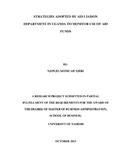| dc.contributor.author | Njonjo, Monicah N | |
| dc.date.accessioned | 2013-11-21T05:49:46Z | |
| dc.date.available | 2013-11-21T05:49:46Z | |
| dc.date.issued | 2013-10 | |
| dc.identifier.citation | Master Of Business Administration, University Of Nairobi, 2013. | en |
| dc.identifier.uri | http://erepository.uonbi.ac.ke:8080/xmlui/handle/123456789/59645 | |
| dc.description.abstract | Any organization needs to have a strategy of how it operates in the ever changing environment so as to ensure it survives in the same environment. Strategy is important in all types of organizations be it an NGO, public sector or private for profit organizations. Strategy ensures that output is maximized using the least resources. In this research project sought to find out which strategies were in use by the Ministry of Finance Planning and Economic Development specifically the aid liaison department in Uganda to monitor the use of aid funds that flowed in the country so as to ensure that the funds went into achieving the development goals. The case study was conducted by way of personal interviews with staff in the aid liaison department, after which content analysis was carried out on the responses received. The research project established that ALD was currently using spread sheet strategy as main way of tracking aid funds but due to several challenges they had adopted a management information system that was in roll out stage and yet to rip the fruits of the MIS. From findings and discussions it is quite clear that ALD were quite clear on the strategies required to monitor the use of aid funds. However, this study discovered that ALD do not have a definite change strategy that would be required to move from the spread sheet strategy and adopt the MIS strategy. The only change strategy they had to manage the change was providing trainings which may not have been sufficient to ensure the successful transition of the spread sheet strategy to the MIS strategy as there were very many factors that needed to be considered when changing the strategy as the MIS strategy would not have been effective if the adoption and implementation was not successful. Suggestions made to ensure successful adoption of MIS were ALD to have a more structured way of changing from one strategy to another so as to manage the challenges that come with shift of strategies. The change strategy ought to be applied to both the ALD staff and also to the development partners who were to interact with the system. Having a change strategy would ensure that it is accepted and success rate is high. Recommendations made for further studies by the researcher were a study could be done in determining the success of implementing the MIS and determine if it solved all the challenges they faced in the spread sheet strategy this would gauge the success of the strategy. Another study recommended was to compare different strategies adopted by several third world countries to monitor use of aid to determine the most successful strategy being used by countries relying heavily on aid. | en |
| dc.language.iso | en | en |
| dc.publisher | University of Nairobi | en |
| dc.title | Strategies adopted by aid liaison department in Uganda to monitor use of aid Funds | en |
| dc.type | Thesis | en |
| local.publisher | School of Business | en |

